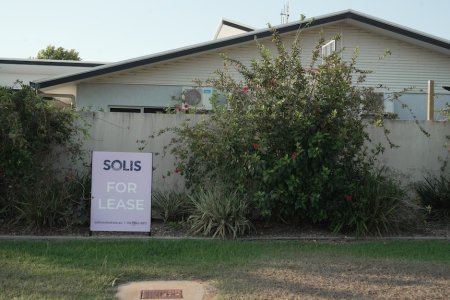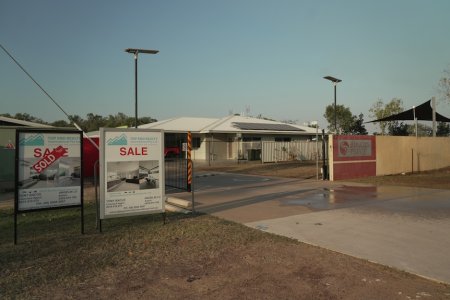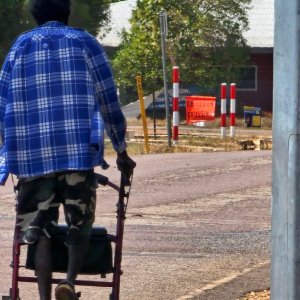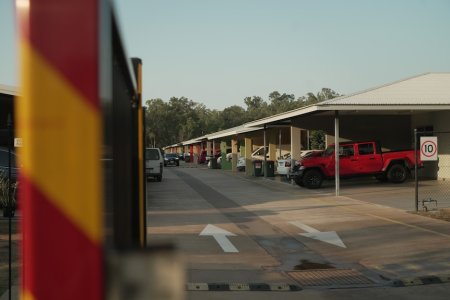
In 2010, a 1 kilometre-long stretch of road in Darwin's north was earmarked for improved pedestrian infrastructure, to support the construction of hundreds of new houses.
A Northern Territory government planning document for then-vacant northern blocks on Boulter Road said future residential developments should establish it 'as a main street through the neighbourhood centre, incorporating public transport, pedestrian infrastructure and street planting for shade and visual amenity'.
Fifteen years later, more than 200 houses have been built along the Berrimah road, with more on the way — but residents and local politicians say the strip remains dangerously underdeveloped.
Street lighting and roadside drainage, installed between 2022 and 2023, are the only infrastructure works that have been completed so far.
Resident Linda Lay, who championed the recent upgrades, said when she bought her home on Boulter Road eight years ago, she had hoped footpaths, shops, roundabouts and pedestrian crossings would one day be built around it.
'I don't know what happened to the plan,' she said.
'Once a couple of years flowed by I sort of thought "Oh well, what happened to it?" and then there was no answer for that.'
City of Darwin councillor Sylvia Klonaris, who helped advocate for the upgrades done so far, said housing developments would continue on Boulter Road despite the lack of supporting infrastructure.
'There's been three actual developments established off Boulter Road, with one new development now,' she said.
'There's about 80 units in [Boulter Estate] and there's approximately 127 in Eden Estate, and Mirawood [has] got about 26 houses there already established.
'The new development is going to have another 48, so there'll be more activity through this area.'

Concerns for pedestrian safety
Boulter Road is also home to a short-stay accommodation complex, social service providers and rehabilitation programs run by the Council for Aboriginal Alcohol Program Services (CAAPS).
CAAPS chief executive Scott McKeen said he saw dozens of clients — including children, the elderly and people with disabilities — walking along the busy road to access those services every day.
'People that we deal with are all vulnerable and require access to public transport, which means they need to get to [major roads] Vanderlin Drive and Amy Johnson Avenue,' he said.
'They have to walk back and forth, and there [are] no footpaths for them to safely do that.
'We need it safe, we need it fixed.'
Resident Jason Desailly said traffic along Boulter Road in the evening was 'madness', and the poor-quality surface made it particularly dangerous for pedestrians.
'At night-time, when you're driving around potholes — and you know there's holes there — you're driving around [and] there's people walking on the roads,' he said.
'It will only be a matter of time before someone gets cleaned up.'
The NT has the highest rate of pedestrian deaths in Australia, with Road Safety NT statistics showing about 20 per cent of all NT road fatalities involve pedestrians.
Residents, local representatives urge action
Cr Klonaris said the design of the planned upgrades on Boulter Road should have started this year, but the amount of funding for them had been reduced in the NT government's latest budget.
'There was an allocated budget for it, which would then take 18 months to deliver,' she said.
'With the new budget in 2026 … unfortunately the treasurer removed the budget, and it's no longer available.'
NT government budget papers show that between the 2024-25 and the 2025-26 budgets, funding for 'headworks infrastructure' in the Berrimah North Area Plan was reduced by more than $2 million, falling from $3.9 million to just under $1.2 million.
Cr Klonaris estimated that it would cost $64 million to upgrade infrastructure in the area encompassing Boulter Road, according to the plans first set out in 2010.
A petition from 217 residents calling for the immediate resurfacing of the entire length of Boulter Road and adjacent footpaths was tabled in NT parliament in May.
In a written response tabled two months later, Infrastructure Minister Bill Yan said the upgrades would 'require detailed planning, design and dedicated capital funding'.
'Potential resurfacing via a reseal is an appropriate interim treatment to seal cracks and minimise pothole formation during the wet season,' he said.
'I am advised that an order of cost estimate, to complete resealing of the full length of Boulter Road, is approximately $250,000.'
Local MLA and NT government minister Jinson Charls said he didn't want a 'blame game' to occur between the territory government and the region's biggest council, and that upgrading Boulter Road had to be priority for both.
Cr Klonaris agreed, but said the NT government needed to do more to guarantee housing developments received supporting infrastructure before they were handed over to councils for maintenance.
'It's only fair in keeping it safe, but also equitable for everyone,' she said.
Written by Oliver Chaseling, ABC News.














